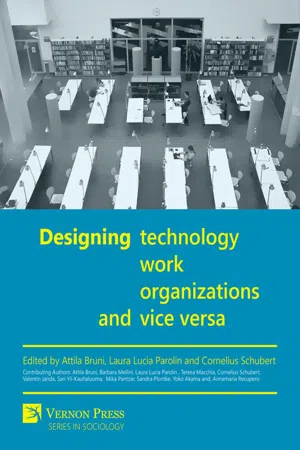
Designing Technology, Work, Organizations and Vice Versa
- English
- ePUB (mobile friendly)
- Available on iOS & Android
Designing Technology, Work, Organizations and Vice Versa
About this book
The concept of design has been defined in a multitude of ways and used in a variety of academic fields, ranging from the classics of organizational and system design to studies on corporate culture, aesthetics and consumption. However, in mainstream organization and management studies, the concept of design has been ‘black-boxed’ and easily implied as an updated (and more fashionable) version of the traditional idea of structuring organizational processes. At the same time, working and organizing seem to be embedded nowadays in increasingly complex and situated technologies and practices. If the spreading of information and communication technologies (ICTs) has changed workplaces (and even the very meaning of 'workplace' as an area marked by the physical presence of different human actors), working and organizing mobilizes the joint action of humans, technologies and knowledges. The aim of the book is thus to discuss the relations among technologies, work and organisations from multiple theoretical perspectives and to engage with questions about design as well as the sociomaterial foundations of working and organising. The book focuses on the close study of practices and processes that inextricably link work and organisation to the use of artefacts and technological systems (and vice versa), exploring by means of different cases of organizational and design research articulations and disarticulations of daily work and design; the doing of objects and technologies in everyday organizational life; the reconstruction of organizational processes through technological and design practices; the relation between learning, innovations and technologies in organizational settings.
The book is addressed to graduate students, PhDs, scholars and researchers interested in the fields of Organization Studies, Science and Technology Studies, Sociology and Design, as well as to professionals and practitioners interested in new methodological approaches towards the relations between technology, work and organization.
Frequently asked questions
- Essential is ideal for learners and professionals who enjoy exploring a wide range of subjects. Access the Essential Library with 800,000+ trusted titles and best-sellers across business, personal growth, and the humanities. Includes unlimited reading time and Standard Read Aloud voice.
- Complete: Perfect for advanced learners and researchers needing full, unrestricted access. Unlock 1.4M+ books across hundreds of subjects, including academic and specialized titles. The Complete Plan also includes advanced features like Premium Read Aloud and Research Assistant.
Please note we cannot support devices running on iOS 13 and Android 7 or earlier. Learn more about using the app.
Information
INDEX
Table of contents
- INTRODUCTION: DESIGNING TECHNOLOGY, WORK, ORGANIZATION AND VICE VERSA
- BUSTER AT WORK:INTERTWINING TECHNOLOGY WITH ORGANIZATIONAL AND WORKING PRACTICES
- DESIGNING ADMINISTRATIVE PRACTICES THROUGH ARTIFACTS:PAPER-BASED REMEMBERING IN BACK-OFFICE WORK
- STUDYING PRACTICES TO INFORM DESIGN: ORGANIZATIONAL ISSUES AND LOCAL ARTIFACTS
- DESIGNING A NEW CHAIR, TRANSGRESSING ORGANIZATIONAL BOUNDARIES
- DESIGN EXHIBITION THROUGH TECHNOLOGICAL INFRASTRUCTURING
- CONTINUOUS RE-CONFIGURING OF INVISIBLE SOCIAL STRUCTURES
- DISTRIBUTED DESIGN TRAJECTORIESTHE GLOBAL MANUFACTURE OF TECHNOLOGIES AND ORGANIZATIONS
- THE MEANS OF DESIGN WORKMODELS, SKETCHES, AND RELATED OBJECTS IN THE CREATION OF NEW TECHNOLOGIES
- HOW THINGS ARE DESIGNED AND HOW THEY DESIGN
- INDEX
- Notes